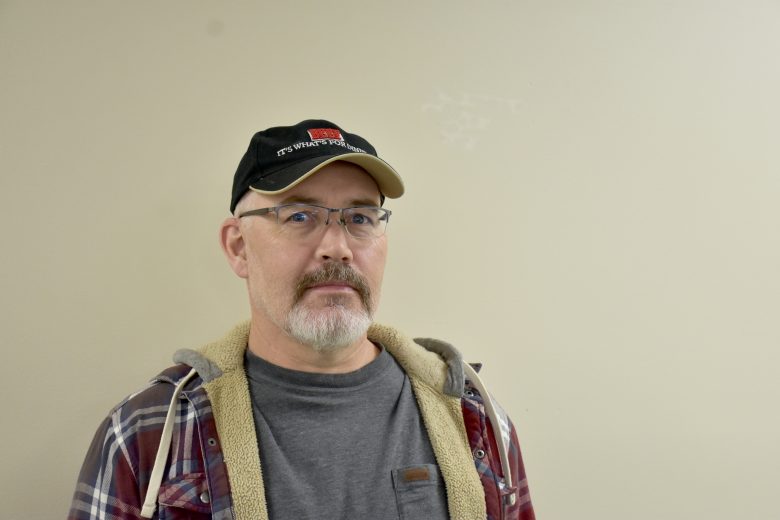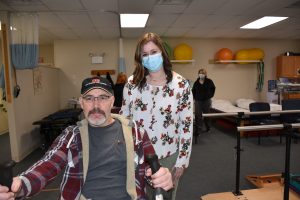
Novel Coronavirus (COVID-19)
Learn about novel coronavirus (COVID-19), our preparedness and updated policies to protect our community, patients, and staff. Learn more here.
Emergency
570-253-8141
Patient Room:
570-253-8609
When prompted enter 3-digit room number
Human Resources
570-253-8995
Wayne Memorial Hospital
601 Park Street
Honesdale, PA 18431
Click the map below for turn by turn directions.

(Honesdale, April 30, 2021)… “My legs were wobbly and my mouth, I couldn’t talk right, it felt numb and floppy,” said Christopher Robson, 51, of that day in March when suddenly nothing in his world felt right. Robson is a stroke survivor, one of several survivors whose stories Wayne Memorial is sharing during Stroke Awareness Month, an observance that calls for increased awareness of the signs and symptoms of stroke and encourages people to act FAST (Face drooping, Arm weakness, Speech difficulty, Time to call 911).
Robson, a manufacturing engineer from Honesdale, said when his stroke happened he knew that “something was ‘electrically’ different.” Standing in his workshop in his garage, reaching for a battery charger, his arm felt “super-glued, like a big blob of dead fish.” He didn’t fall but lowered himself to the ground and called his wife to contact 911 and then his daughter to help him.
The EMS crew understood immediately what was going on, said Robson. “They had this energy, very focused, like they knew the clock was ticking.” When a stroke occurs, minutes count– every minute lost means loss of brain tissue or function.
The ambulance’s EMTs (Emergency Medical Technicians) had already alerted Wayne Memorial Hospital, a certified primary stroke center that was recently awarded the American Heart Association’s highest stroke award, the “Get with the Guidelines” Gold Plus award. When Robson arrived, the Stroke Alert Response Team was ready for him. Within minutes, he was given a CT scan to determine what type of stroke he was having and then set up via teleconference with a board-certified neurologist from Geisinger Health System.
“They gave me tPA and then took me to the helipad,” Robson remembered, “it all happened really fast.”
Tissue Plasminogen Activator (tPA) helps in restoring blood flow to the brain –“it’s also called a clot buster drug,” said Stanley Skonieczki, MD, the medical director of Wayne Memorial’s Emergency Department. “As a certified primary stroke center, we are authorized to administer this life-saving drug when appropriate, but to be effective, it must be given within three hours, or up to four-and-half hours, after the onset of symptoms.”
“It was ‘crystal clear’ to me that everyone at Wayne Memorial knew exactly what they were doing,” said Robson, adding, “As a manufacturing engineer, believe me, I can sense when something is not right with the team in the room. There was none of that. These folks had everything under control. And because of that, I really wasn’t scared or uncomfortable.”
Robson was life-flighted to Geisinger Wyoming Valley where he underwent a breakthrough type of surgical procedure called “stent retrieval thrombectomy” to restore blood flow to the brain. During this procedure, a catheter is threaded into an artery at the groin and up through the neck, until it reaches the blood clot causing the stroke. Using x-ray guided imaging, a “stent retriever” is inserted into the catheter. The stent reaches past the clot, expands to stretch the walls of the artery so blood may flow, and the clot is “retrieved.” Removing blood clots from the brain leads to better outcomes for stroke patients.
The procedure is performed under conscious or moderate sedation.
“I was awake and it hurt like heck! But I’m here today because of all the teamwork and fast thinking by Wayne Memorial’s staff. Really, I can’t thank them enough.”
Later, Robson was transferred to the Wayne Memorial-Good Shepherd Inpatient Rehabilitation Center to undergo intense physical therapy.
What brought on the stroke? While there are well-known risk factors, Robson said he doesn’t fall into any of the usual categories. For example, he doesn’t have high blood pressure or a history of smoking. What about a family history? “Odd thing is, my sister had a stroke, too, on the same day as I did—March 12th.” Robson said he and his medical advisers are still not sure what brought on the stroke, but they are looking at everything, including any possible cardiac issues that may not have been fully identified.
Today, less than a month after his stroke, Robson is in outpatient occupational and speech therapy at Wayne Memorial Hospital’s Delaware Street Rehab facility. During a recent visit, accompanied by his wife, Wayne Highlands High School Band Director Betty Ann, Robson reiterated how thankful he was. “The staff training in the hospital’s E-R really showed through, and I’m grateful for that.”
Certified Primary Stroke Center | Wayne Memorial Hospital (wmh.org)
Christopher Robson did the right thing: he did not ignore his symptoms. He called for help rather than hoping things would just go away. If you or somebody you know experiences the signs of stroke, call 911 immediately. Think FAST: Facial drooping, Arm weakness, Speech difficulty = Time to call for help!

Photo: Christopher Robson with Maura McGowan, DPT at Wayne Memorial Rehabilitation Services/Delaware Street.